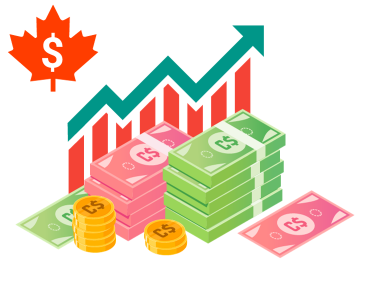The CAD-USD exchange rate is a topic of great interest for many individuals, businesses and governments around the world. Understanding the significance of this rate is crucial for anyone involved in international trade, investment or travel. In this article, we will explore the importance and implications of the CAD-USD exchange rate, examining why it matters and what factors influence it. We will also delve into the role of the Bank of Canada in managing this rate and compare it to other major currencies. Additionally, we will make predictions about its future and consider how it impacts international trade and investment. Lastly, we will provide some tips for travellers on how to get the best exchange rate when converting CAD to USD.
Why the CAD-USD exchange rate matters
The CAD-USD exchange rate matters because it has a significant impact on the Canadian economy and the daily lives of Canadians. The exchange rate refers to the value of the Canadian dollar in relation to the US dollar, and it affects everything from the prices of goods and services to international trade and investment. A high CAD-USD exchange rate means that the Canadian dollar is stronger than the US dollar, making Canadian exports more expensive for foreign buyers and imports cheaper for Canadians. Conversely, a low CAD-USD exchange rate means that the Canadian dollar is weaker than the US dollar, making Canadian exports cheaper for foreign buyers and imports more expensive for Canadians. This can have a major impact on businesses that rely on international trade, as well as consumers who purchase goods and services from other countries. In addition, fluctuations in the CAD-USD exchange rate can affect the cost of travel for Canadians visiting the United States or Americans visiting Canada. Overall, understanding the CAD-USD exchange rate is crucial for anyone who wants to stay informed about economic trends and make informed decisions about their finances.
The factors that influence the CAD-USD exchange rate
The CAD-USD exchange rate is influenced by a variety of factors, including economic indicators, political events, and market sentiment. One key factor that impacts the exchange rate is interest rates. When interest rates in Canada rise, it can attract foreign investment, increasing demand for Canadian dollars and driving up the exchange rate. Conversely, when interest rates in the US rise, it can lead to a decrease in demand for Canadian dollars and a decline in the exchange rate. Another factor that influences the exchange rate is commodity prices. As Canada is a major exporter of commodities such as oil and lumber, fluctuations in commodity prices can impact the value of the Canadian dollar. For example, if global oil prices increase, it can lead to an increase in demand for Canadian dollars as investors seek to purchase oil from Canada. Additionally, political events such as elections or changes in government policies can also impact the exchange rate. For instance, uncertainty surrounding trade relations between Canada and the US can lead to fluctuations in the exchange rate. Finally, market sentiment and investor confidence can play a role in determining the exchange rate. If investors are optimistic about the Canadian economy and its prospects for growth, they may be more likely to invest in Canadian assets, increasing demand for Canadian dollars and driving up the exchange rate. Conversely, if investors are pessimistic about the Canadian economy or global economic conditions, they may be more likely to sell Canadian assets and invest elsewhere, leading to a decline in the exchange rate.
The role of the Bank of Canada in managing the CAD-USD exchange rate
The Bank of Canada plays a crucial role in managing the CAD-USD exchange rate. It is responsible for implementing monetary policy, which includes setting interest rates and adjusting the money supply. These actions can have a significant impact on the exchange rate. For example, if the Bank of Canada raises interest rates, it can make holding Canadian dollars more attractive to investors, leading to an increase in demand and a strengthening of the CAD relative to the USD. Conversely, if the Bank of Canada lowers interest rates, it can make holding Canadian dollars less attractive, leading to a decrease in demand and a weakening of the CAD relative to the USD.
In addition to setting interest rates, the Bank of Canada also intervenes directly in foreign exchange markets to influence the exchange rate. This typically involves buying or selling Canadian dollars on the open market. If the Bank of Canada wants to strengthen the CAD relative to the USD, it can buy Canadian dollars using its foreign reserves, thereby increasing demand for CAD and pushing up its value. Similarly, if it wants to weaken the CAD relative to the USD, it can sell Canadian dollars on the open market, thereby increasing supply and pushing down its value.
Overall, the Bank of Canada’s role in managing the CAD-USD exchange rate is crucial for maintaining economic stability and promoting trade and investment. By setting interest rates and intervening in foreign exchange markets as needed, it can help ensure that fluctuations in the exchange rate do not have negative consequences for Canadian businesses and consumers.
Comparing the CAD-USD exchange rate to other major currencies
When it comes to the CAD-USD exchange rate, it’s important to understand how it compares to other major currencies. The Canadian dollar is often compared to the US dollar due to the close economic ties between the two countries, but it’s also essential to consider other currencies such as the Euro, Japanese Yen, and British Pound. The exchange rate between these currencies can have significant implications for trade and investment. For instance, a strong CAD relative to the USD can make Canadian goods more expensive for American consumers, potentially leading to a decrease in exports and economic growth. On the other hand, a weak CAD relative to the Euro can make Canadian goods more affordable for European consumers, leading to an increase in exports and economic growth. It’s also worth noting that the CAD-USD exchange rate can be influenced by external factors such as political events, global economic trends, and changes in commodity prices. Therefore, it’s crucial to keep an eye on these factors when comparing the CAD-USD exchange rate to other major currencies. Overall, understanding how the CAD-USD exchange rate compares to other major currencies can provide valuable insights into international trade and investment opportunities.
Predictions for the future of the CAD-USD exchange rate
The CAD-USD exchange rate is subject to fluctuations due to various economic and political factors. The future of this exchange rate is uncertain, and it can be challenging to make accurate predictions. However, many experts believe that the CAD-USD exchange rate will remain stable in the near future. This stability can be attributed to several factors, including the strengthening of the Canadian economy, a decline in US interest rates, and increased demand for Canadian exports. Additionally, the recent trade agreement between Canada, Mexico, and the United States has brought more stability to the CAD-USD exchange rate. Despite this stability, some analysts predict that the CAD may weaken against the USD due to rising global trade tensions and geopolitical risks. Furthermore, any significant changes in oil prices could also impact the CAD-USD exchange rate as Canada is a major exporter of oil. It is essential to note that predicting exchange rates accurately is notoriously difficult, and even the most experienced analysts can get it wrong. As such, it is advisable to keep track of economic indicators and political developments that may affect the CAD-USD exchange rate. In conclusion, while the future of the CAD-USD exchange rate remains uncertain, current trends suggest that it will remain relatively stable in the near future, but external factors could quickly change this outlook.
Impact of the CAD-USD exchange rate on international trade and investment
The CAD-USD exchange rate has a significant impact on international trade and investment. When the Canadian dollar appreciates against the US dollar, Canadian exports become more expensive for American buyers, leading to a decrease in demand for Canadian goods. This, in turn, can lead to a decline in exports and economic growth in Canada. On the other hand, when the Canadian dollar depreciates against the US dollar, Canadian exports become cheaper for American buyers, leading to an increase in demand for Canadian goods and an increase in exports. This can lead to an increase in economic growth in Canada.
The impact of the CAD-USD exchange rate is not limited to Canada and the United States. Other countries that trade with Canada or the United States can also be affected by changes in the exchange rate between these two currencies. For example, if Canada’s exports to the United States decrease due to a stronger Canadian dollar, this could lead to a decrease in demand for raw materials from other countries that supply Canada with inputs for its exports.
Furthermore, changes in the CAD-USD exchange rate can also affect investment flows between Canada and the United States. When the Canadian dollar appreciates against the US dollar, it becomes more expensive for Americans to invest in Canada, which can lead to a decrease in foreign investment in Canada. Conversely, when the Canadian dollar depreciates against the US dollar, it becomes cheaper for Americans to invest in Canada, which can lead to an increase in foreign investment in Canada.
In summary, the CAD-USD exchange rate plays a crucial role in international trade and investment. Fluctuations in this exchange rate can have significant implications for both Canadian and American economies as well as for other countries that trade with them.
Tips for travellers: How to get the best exchange rate when converting CAD to USD
Travellers who are planning to visit the United States should know that getting the best exchange rate when converting CAD to USD can save them a significant amount of money. One of the first things they should do is to compare exchange rates from various sources, such as banks, credit unions, and currency exchange companies. They should also check for any fees or commissions that may be charged for the service. In general, it’s best to avoid exchanging currency at airports or hotels, as they tend to offer less favourable rates. Another tip is to consider using a credit card instead of cash, as some credit cards offer better exchange rates than others. Travellers should inform their bank and credit card company about their travel plans beforehand to avoid any issues with fraud alerts or blocked transactions. It’s also a good idea to carry some cash in small denominations for emergencies or situations where credit cards may not be accepted. Finally, travellers should be aware of the current exchange rate and how it fluctuates over time. They can use online currency converters or mobile apps to stay updated on the latest rates. By following these tips, travellers can ensure that they get the best exchange rate when converting CAD to USD and make the most out of their trip to the United States.
Understanding the CAD-USD exchange rate is crucial for anyone interested in international trade, investment or travel. The exchange rate reflects the relative strength of two major economies and can have significant implications on financial markets and consumer behaviour. As we have seen, there are several factors that influence the exchange rate, including economic policies, geopolitical events and market sentiment. While it is difficult to predict the future of the CAD-USD exchange rate with certainty, staying informed about economic developments and global trends can help individuals and businesses make better decisions. As we continue to navigate an increasingly interconnected world, it is important to recognise the impact that exchange rates can have on our daily lives. With this in mind, we should strive to deepen our understanding of currency markets and their role in shaping our global economy.






Leave a Reply